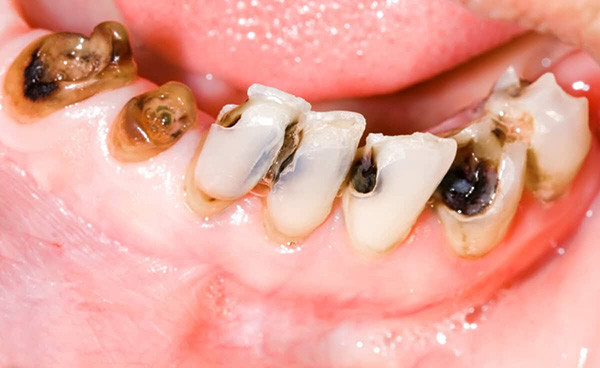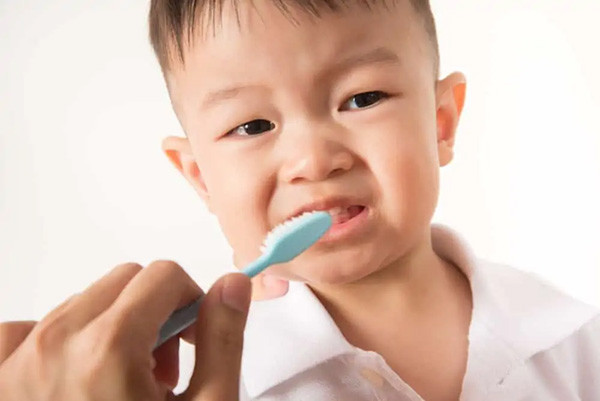Not only candy, but also starchy foods, sugary drinks, and poor oral hygiene are causes of tooth decay. To better understand its causes, formation mechanisms, and effective prevention methods, we invite you to explore the article below with experts at My Auris Dental Clinic – where precise information on tooth decay is shared from a dental professional’s perspective, helping you proactively protect your oral health.
Why Does Eating Candy Cause Tooth Decay?
Why do babies get tooth decay from eating candy is a classic question asked whenever sweets are mentioned. In reality, candies like lollipops, hard candies, and chewing gum all contain sugar – a common factor frequently warned about due to its potential impact on overall health. However, sugar alone doesn’t cause tooth decay. Bacteria are the actual culprits, as they create gaps on the tooth surface through chemical reactions after you digest sugar, or carbohydrates.
When you eat sweets, plaque – a mixture of bacteria and saliva – begins to accumulate. If this plaque is not removed promptly, bacteria and saliva cause tooth decay by eroding tooth enamel. Small holes on the teeth during the early stages of decay are easily recognizable signs, but also the first step in a series of serious damages.
These small holes in the enamel cause significant damage, as plaque – a strong mixture of acids and bacteria – can penetrate deeply through the layers of the tooth, reaching the pulp, blood vessels, and nerves. When the tooth pulp is damaged, you may experience sensitivity in the supporting bone, reducing your daily quality of life.
Although many everyday foods contain carbohydrates like rice and bread, the belief that eating candy causes tooth decay remains classic due to its tendency to get stuck and be difficult to clean. Sugar in candy promotes bacteria, but it’s the bacteria’s ability to hide, along with small, hard-to-remove candy pieces stuck between teeth, that makes candy more likely to cause tooth decay than other foods.

Tips to avoid tooth decay after eating candy and sweets:
Eat sweets during main meals instead of as snacks, which helps produce more saliva to neutralize acids.
Eat faster to reduce the time sugar is in contact with teeth, limiting bacterial activity.
Avoid sticky sweets like raisins, toffees, which easily cause long-lasting plaque.
Prioritize natural sugars over processed ones; for example, eat sweet berries or apples without adding extra milk or sugar.
After eating sweets, rinse your mouth with water or chew sugar-free gum to stimulate saliva production and neutralize harmful acids.
Tooth Decay and Its Causes
Tooth Decay: A Common Pathology Across All Ages
Tooth decay is a common dental pathology that can occur at all ages. Characteristic symptoms include the appearance of small white, brown, or black holes on the tooth surface, accompanied by toothache and sensitive teeth, especially when eating sweets, hot, cold, or hard foods. This condition involves damage to the hard tissues of the tooth; if not detected and treated promptly, it can lead to dangerous complications such as pulpitis, periapical abscess, and even permanent tooth loss.
Early signs of tooth decay to recognize:
- Small white, brown, or black holes on the tooth surface.
- Pain when eating sweets, hot, cold, or when biting hard food.
- Teeth sensitive to temperature or external stimuli.
- Swollen gums, especially in the area of the decayed tooth.
- Unpleasant breath (halitosis).

Common Causes of Tooth Decay Today
Tooth decay is a complex condition caused by multiple interacting factors:
- Cavity-causing bacteria, especially Streptococcus mutans, convert sugar from food into acid. This acid attacks tooth enamel, creating small holes that spread deeper into the tooth – the origin of tooth decay.
- Sugary foods like candy, pastries, and soft drinks provide a favorable environment for bacteria to thrive. Bacteria use sugar as their preferred food, producing harmful acids.
- Poor oral hygiene: Improper brushing, not using dental floss, or not rinsing after meals allows food debris to stick to teeth, forming plaque. If not cleaned, plaque hardens into tartar, providing an ideal condition for bacteria to grow.
- Dry mouth: This can be caused by medication, medical conditions, or aging, leading to reduced saliva production. This decreases the ability to neutralize acids, thereby reducing protection against bacteria and increasing the risk of tooth decay.
- Genetic factors affecting tooth decay: Some individuals have weaker tooth enamel, making them more susceptible to bacterial attack than others.

Is Eating Candy a Direct Cause of Tooth Decay?
The saying “eating candy causes tooth decay” is not entirely true, but not entirely false either. In reality, eating candy can increase the risk of tooth decay because:
- Candy contains a lot of sugar – a favorite food for bacteria, helping them produce acids that destroy tooth enamel.
- Candy sticks to teeth, especially in hard-to-clean interdental spaces, creating conditions for bacteria to multiply.
- Some candies stimulate saliva production, but they also dilute saliva, significantly reducing its ability to neutralize acids.
Therefore, not everyone who eats candy will get tooth decay. If you have good oral hygiene habits, such as brushing correctly, using dental floss, and rinsing after meals, you can completely limit the harmful effects of sugar on tooth enamel.
Treating Tooth Decay
Preventing Tooth Decay Caused by Eating Candy
Tooth decay caused by eating candy can be completely controlled and prevented if you apply the correct methods. Here are some ways to prevent tooth decay from candy for you and your family:
- Limit candy and sweets: Prioritize reducing the consumption of chewy candies, caramels, and lollipops – types that stick to teeth longer and damage enamel.
- Maintain thorough daily oral hygiene: Brush twice a day for at least 2 minutes each time, combine with flossing to clean between teeth, and rinse after eating, especially after consuming candy.
- Use fluoride mouthwash: Helps strengthen tooth enamel, effectively protecting teeth from decay.
- Chew sugar-free gum: Helps stimulate saliva production, thereby neutralizing acids in the oral cavity – a factor that erodes tooth enamel.
- Regular dental check-ups every 6 months: Your dentist will help you check your oral health and detect early signs of tooth decay for timely treatment.
These measures are not only applicable to tooth decay caused by eating candy but are also essential for general tooth decay prevention.
How to Treat Tooth Decay According to Its Severity
Depending on the severity of tooth decay after examination and evaluation, the dentist will prescribe appropriate treatment.
Mild Tooth Decay
When tooth decay is mild, dental filling is often prescribed. The dentist will remove the decayed part of the tooth and use composite, GIC, porcelain, or suitable filling materials to restore the tooth structure. This is a common, minimally invasive solution that effectively preserves the natural tooth.
Severe Tooth Decay
- Root canal treatment: When bacteria have spread to the tooth pulp causing inflammation, the dentist needs to remove the damaged pulp, then fill the root canal or crown the tooth to protect it.
- Dental crowning: Applied when the tooth is extensively decayed and weakened, aiming to restore chewing function and protect the tooth from external forces.
Serious Tooth Decay
If the tooth is severely damaged and cannot be preserved, extraction is the last resort. The extraction process will be performed carefully to avoid pain and affecting other teeth. Afterwards, the dentist may recommend dentures or dental implants to ensure chewing function and aesthetics.
Throughout the treatment process, the dentist may prescribe pain relievers and antibiotics to support treatment and alleviate symptoms for the patient.

Effective and Scientific Tooth Decay Prevention Methods from a Dentist’s Perspective
To effectively prevent tooth decay, you need to establish proper daily oral hygiene habits. Here are the dental measures recommended by experts:
Brush twice a day with fluoride toothpaste, ensuring a fluoride content of 1350–1500 ppm. Brushing for two minutes with proper technique helps remove plaque and bacteria – the main causes of tooth decay. (Fluoride effectively protects teeth from decay and strengthens tooth enamel).
Clean between teeth daily with dental floss or special interdental brushes, helping to reduce the risk of decay between teeth – areas that regular toothbrushes struggle to reach.
Limit the consumption of carbohydrate-rich foods like candies, sweets, soft drinks, and restrict acidic foods like pickled vegetables, lemon juice, etc., as these can increase the risk of tooth decay if consumed regularly.
After meals, you can chew sugar-free gum to stimulate saliva production – a natural mechanism that helps clean teeth and neutralize acids in the oral cavity.
Visit the dentist regularly 1–2 times a year for professional dental cleaning, early detection of dental issues, and timely treatment.
For individuals who frequently experience tooth decay, using an additional fluoride mouthwash is an effective supportive solution, enhancing the ability to prevent tooth decay.
For children, parents should consult a dentist about sealing fissures on chewing teeth, which helps protect primary and permanent teeth and effectively prevents tooth decay.
Depending on each individual’s specific condition, the dentist will recommend other appropriate preventive measures. Proactively protecting oral health by brushing correctly, choosing the right toothpaste, cleaning between teeth, and visiting the dentist regularly not only helps maintain good oral health but is also a crucial step in comprehensively protecting overall health.





